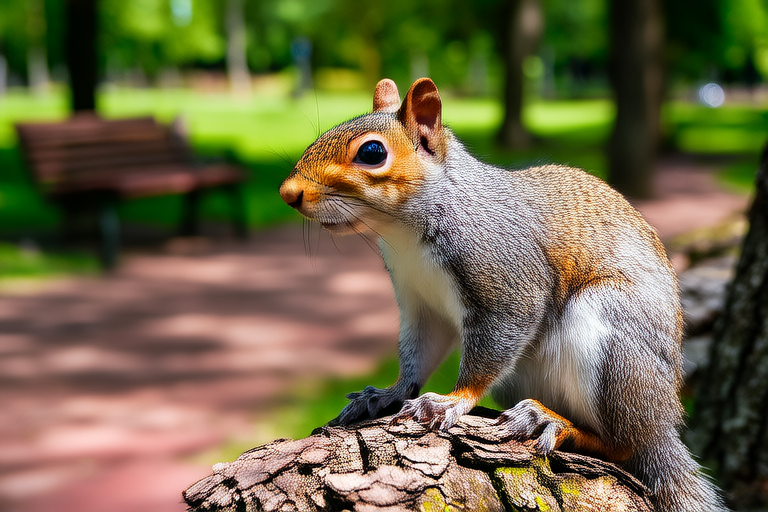From Backyard to Park Bench: Where to Spot Your Local Squirrels
Welcome to the world of squirrels! These agile, bushy-tailed creatures are a common sight in many urban and rural areas, offering a delightful opportunity for wildlife watching. Whether you’re a seasoned nature enthusiast or just starting out, this guide will help you identify local squirrel species, find the best times and places for sightings, and understand how to observe them safely. Let’s dive into the fascinating lives of these small but significant animals.
Identifying Local Squirrel Species
The first step in enjoying squirrel watching is learning to distinguish between different species. In North America, the most common species include the Eastern Gray Squirrel (Sciurus carolinensis), the Fox Squirrel (Sciurus niger), and the Red Squirrel (Sciurus vulgaris). Each has distinct physical characteristics:
- Eastern Gray Squirrels: These are medium-sized, with gray fur that can range from silver to brown. They have white bellies and large, bushy tails. They are often found in deciduous forests and urban parks.
- Fox Squirrels: Larger than gray squirrels, fox squirrels have reddish-brown fur with lighter underbellies. Their tails are also bushy but tend to be more reddish in color. They prefer open woodlands and suburban areas.
- Red Squirrels: Smaller and more slender than the other two species, red squirrels have reddish-brown fur with white underparts. They have distinctive ear tufts during the winter months and are usually found in coniferous forests.
Learning these differences can enhance your experience by helping you appreciate the variety within the squirrel family.
Ideal Times and Locations for Sightings
Squirrels are diurnal, meaning they are most active during the day, particularly in the early morning and late afternoon. This makes these times ideal for observation. Here are some great locations where you might spot them:
- Parks and Gardens: Urban green spaces like city parks and botanical gardens offer ample opportunities to watch squirrels. These areas provide food sources such as nuts, seeds, and even human-provided treats. Look for feeding stations, trees, and open grassy areas.
- Forests and Woodlands: If you prefer a quieter setting, consider visiting local forests and woodlands. Squirrels are often seen climbing trees, foraging on the ground, or gathering nuts and seeds. Early morning visits are especially rewarding.
- Your Own Backyard: Don’t underestimate the potential right outside your door. Planting native trees and shrubs can attract squirrels. Bird feeders can also serve as a reliable food source, making your backyard a regular stop for these curious creatures.
Remember, patience is key. Squirrels can be skittish, so it may take some time before they become comfortable enough to let you observe them closely.
Safety Precautions When Observing Squirrels
While squirrels are generally harmless, there are some safety considerations to keep in mind when observing them:
- Keep a Safe Distance: While squirrels are not typically aggressive, it’s important to maintain a respectful distance. Avoid startling them or encroaching on their personal space.
- Avoid Feeding: Feeding wild animals can alter their natural behaviors and make them dependent on humans. Stick to observing rather than interacting directly.
- Respect Wildlife Laws: Some areas have regulations regarding wildlife interaction. Be sure to familiarize yourself with local laws to ensure responsible wildlife watching.
By following these guidelines, you can enjoy observing squirrels while respecting their habitat and well-being.
Fun Facts About Squirrels
To deepen your appreciation for these fascinating creatures, here are some interesting facts about squirrels:
- Storage Masters: Squirrels are known for their ability to bury nuts and seeds. They can remember the location of thousands of caches, which helps them survive harsh winters.
- Superior Climbers: Equipped with sharp claws and strong limbs, squirrels are excellent climbers. They can leap up to six feet from branch to branch, making them acrobatic gymnasts in the treetops.
- Nocturnal Adaptation: Although primarily diurnal, squirrels can adapt to nocturnal habits if necessary, especially in urban environments where food sources are abundant at night.
- Communication Experts: Squirrels use a variety of vocalizations and body language to communicate with each other. Pay attention to their chirps and tail flicks to better understand their interactions.
These facts highlight the intelligence and adaptability of squirrels, making them even more intriguing subjects for wildlife watching.
Tips for Novice and Experienced Wildlife Watchers
Whether you’re new to wildlife watching or a seasoned observer, here are some practical tips to enhance your experience:
For Novices
- Start Close to Home: Begin your observations in familiar surroundings, such as your backyard or a nearby park. This reduces stress and allows you to focus on learning without worrying about logistics.
- Use Binoculars: A good pair of binoculars can help you get a closer look at squirrels without disturbing them. Opt for compact models with a magnification power of around 8x.
- Stay Quiet: Move slowly and quietly to avoid startling the squirrels. Practice mindfulness and patience; the rewards are worth the effort.
For Experienced Watchers
- Photography Techniques: Improve your photography skills by experimenting with different angles and lighting conditions. Consider investing in a telephoto lens for clearer images.
- Field Guides and Apps: Utilize field guides and smartphone apps to identify and learn more about the specific species you encounter. These resources can also help track your sightings and improve your identification skills.
- Join Local Groups: Connect with other wildlife enthusiasts through local clubs or online forums. Sharing experiences and insights can enrich your knowledge and passion for wildlife watching.
By applying these tips, you can enhance your enjoyment and deepen your connection with the natural world.
Conclusion
From backyards to park benches, squirrels offer endless opportunities for observation and appreciation. By learning to identify local species, choosing the right times and locations for sightings, and following safety precautions, you can become a more informed and responsible wildlife watcher. Armed with fun facts and practical advice, you’re ready to embark on a rewarding journey into the world of squirrels. Happy watching!
